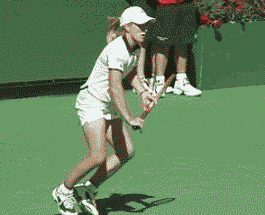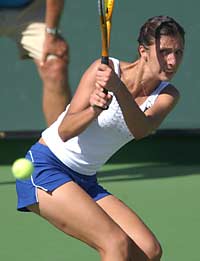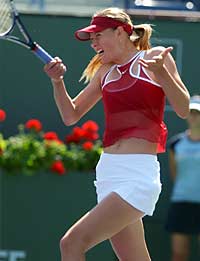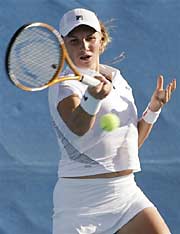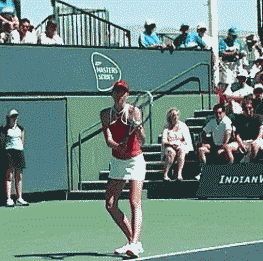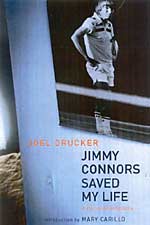|
TennisOne Features Women's Tennis 2004: So Who's Number One? By Joel Drucker
So now that the dust has settled on the 2004 women's tennis season, who's the year's number one player? It's unquestionably the wackiest year-ending scenario in tennis history. Way back in January, Justine Henin-Hardenne, number one in 2003, picked up where she left by winning the Australian Open and dominating the first three months of 2004. But then she fell prey to a virus and, save for her gold medal effort at the Olympics, has scarcely played. Three different Russians - Anastasia Myskina, Maria Sharapova, Svetlana Kuznetsova - each earned Grand Slam titles, but failed to post enough significant results elsewhere to earn the top spot on the computer. Though Amelie Mauresmo failed to reach a Grand Slam final, her superb efforts at smaller events helped her briefly reach number one. Then there's Lindsay Davenport, who won seven titles but also never got past the semis of any of the four Slams. I'm not about to use this space to advocate a sweeping reform of the WTA computer. But what's revealed by all this confusion and clutter? Answer: The eternal tennis principle that unlike team sports, where each organization plays the same number of games against the same set of opponents, all leading up to an obvious pinnacle of a conclusion (Super Bowl, World Series), tennis is a game of individuals. And each individual pursues her own path to success, winning and losing at disparate events, suffering injuries at different stages in the year, opting to play certain tournaments while skipping others.
More pointedly, there is no easy fix for what's happened this year. No one is to blame for it. But what's sad is that tennis, a sport consistently handicapped in its effort to gain public acceptance, has found itself unable to truly crown a true women's champion for 2004.
If you draw on the model from baseball, then indeed Davenport is number one based on sheer consistency. Just like the player who leads the league in batting, she has posted the best set of high-quality results across the length of an entire season. Considering she's done so at the age of 28, after suffering two years worth of injuries (including operations on a knee and a foot), it's a warm and fuzzy story. A year-ending win at the WTA Championships in LA might have added a nice exclamation point to her renaissance season. She's also spoken enthusiastically about 2005. But as much as I admire so much about Davenport - from her work ethic to her groundstrokes to her straightforward manner -- I can't say the world's best woman in 2004 was someone who didn't even make it to the finals of a Grand Slam. Instead, I'm basing my decision more on the model of pro football, tossing aside 52 weeks of consistency in favor of the player with the best high-impact results at the big occasions. So call me crazy, but in my view the Player of the Year in 2004 was Maria Sharapova. First, she won the sport's most prestigious title, Wimbledon, knocking off Davenport in the semis and Serena Williams in the finals. I'll admit her results elsewhere were negligible - nothing better than a quarterfinal effort at the French Open.
But then, at last week's year-end championship, she stepped up, toppling three Russians - Myskina, Kuznetsova and Vera Zvonereva - she'd never beaten before. Her final win over Serena Williams was a roller coaster of a match, unfortunately marred by an abdominal injury that left Williams so addled she was barely able to serve. But credit Sharapova for coming back from 4-0 down in the third set against an opponent who was brazenly blazing her way through pain - at least for a time. Of course there's another way to look at this too: Must we make someone number one? Why is it necessary to issue a conclusive verdict? Can't we just accept the computer rankings and move on? Once upon a time the year-end rankings were determined by various panels of experts. But even though that lingered into the Open era, as the game has become more professionalized, the need for more quantifiable analysis grows. Yet in large part, the computer exists less for players in the top five and more for those further down the charts to whom so much is riding - points, endorsement bonuses, etc. Nice as it is for Davenport to have reached the top, I'll bet every cent I possess that she'd gladly have traded in that ranking for a Slam. Wouldn't you? Your comments are welcome. Let us know what you think about Joel Drucker's article by emailing us here at TennisOne .
Jimmy Connors Saved My Life: A Personal Biography Longstanding TennisOne writer Joel Drucker has just published his first book, Jimmy Connors Saved My Life: A Personal Biography. Mr. Drucker provides the most thorough examination ever attempted of one of the most complex characters in recent sports history. The book is both a comprehensive biography of the controversial tennis star and a look at how the author's life intersected and conflicted with Jimbo's. The book includes extensive analysis of Connors' tennis, including the vital impact his mother had as his primary coach, as well as the significant work the great Pancho Segura did in his formative years. Also covered are a great many of Connors' most important matches, as well as many personal interactions Drucker had with Connors that reveal unusual sides to him. |

